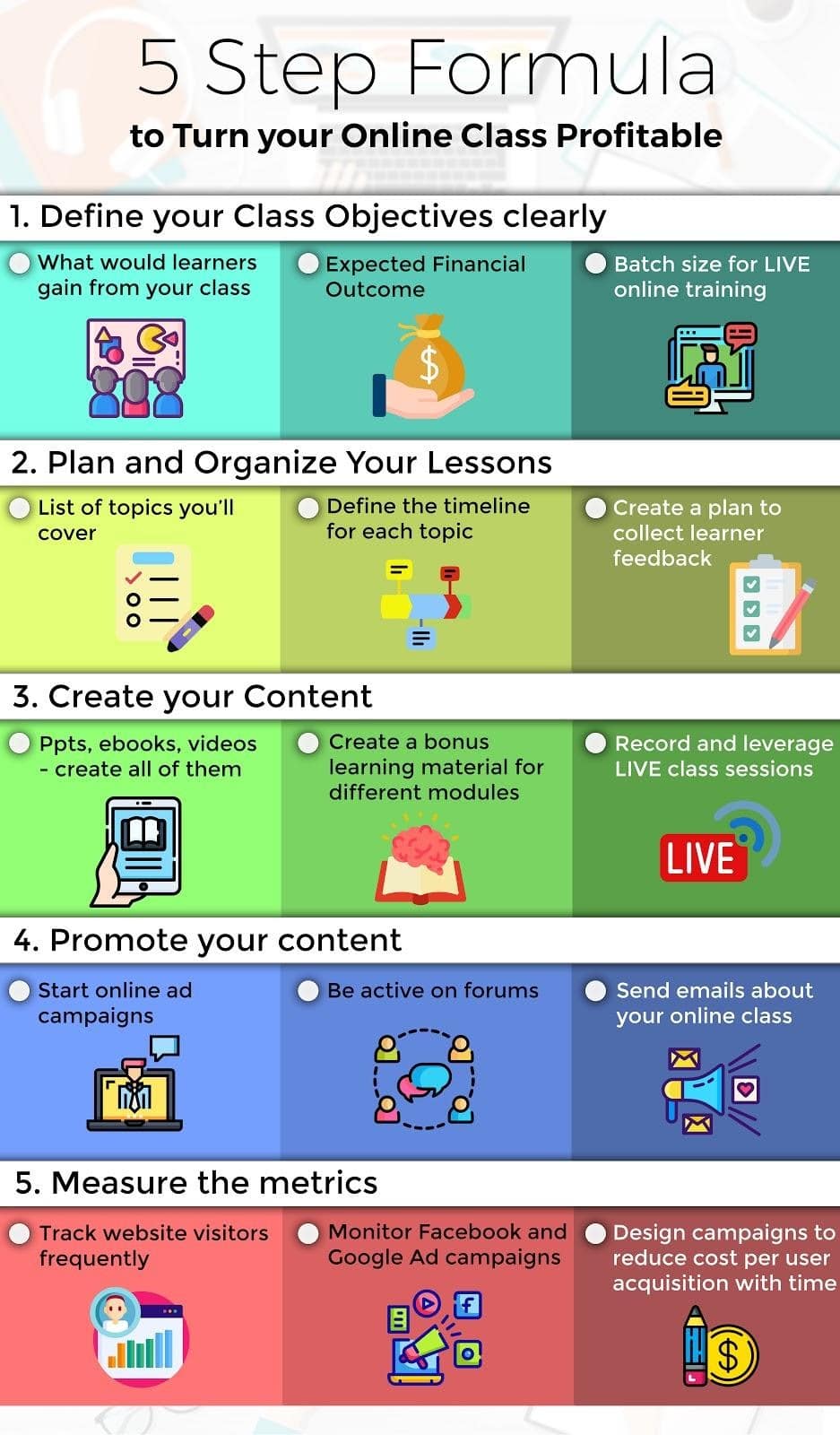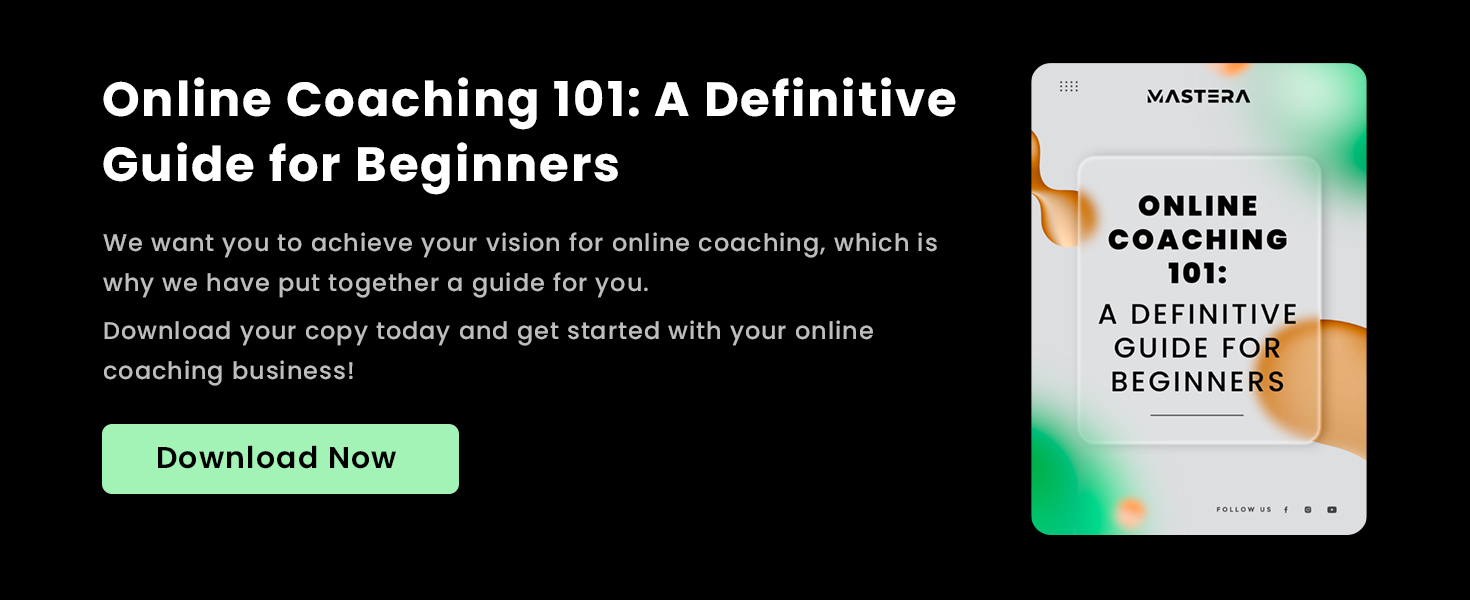Regardless of your qualifications, you probably have something you would like to share with the rest of the world. It could be a passion of yours, or something you’ve always wanted to teach other people.
These days many online content creators are starting professional courses, and in the process, they impart valuable knowledge while earning money for themselves.
The days of attracting prospective students through vague promises are long gone, and you must prove to them that you have the required expertise needed to educate them.
Launching an online course may seem a little intimidating at first, since there are many things you need to keep in mind. As such, you might get confused or be at a loss for ideas at times. So, here are five essential steps you need to follow to start profitable online classes.
5 Steps To Creating A Massively Successful Online Course in 2025
Here how you can create a successful online course in 5 easy steps:
Step 1: Clearly Define Your Objectives
Define your business objectives and the kind of impact you wish to create through these classes.
For instance, if you are creating courses for your well-established business, your goal might be to teach other people how to interact with a specific interface or tool.
Conversely, if you are launching classes on behalf of an educational institution, you might want to share knowledge remotely with students who cannot readily receive a classroom education.
Due to the COVID pandemic, several academic bodies have recently started delivering online lectures to their students.
So, the first step is to define the following things:
- The expected financial outcome for the online classes.
- The goal of imparting education to others, whether it is to allow customers to be more comfortable with a tool or to impart product knowledge.
- The goal from the perspective of the pupil, i.e. what they would gain from it.
You should also decide on the core concepts that you will build the classes around. This will bring in new learners and allow you to concentrate on creating valuable content. For example, if you are creating content for a business school, you might include the following:
- Information related to finding new customers
- How to reach out to these customers
- How to convert these potential customers into paying clients
The topics you include in your lessons should be relevant for the long-term. It is wise to avoid trends because they tend to rapidly sink into obsolescence, which means you will need to create new content once again.
Thus, you need to be very clear regarding what you want and what students want to help them reach their goals through your lessons.
Step 2: Plan and Organize Your Lessons
Once you have identified your target audience and decided on the main topics you will focus on, you can start planning the lessons, organizing them into topics and subtopics.
But, while doing this, you must not forget the main objective of creating the classes is to fulfill students’ learning demands.
You can organize the course curriculum based on difficulty levels, a particular teaching approach, or any other suitable category. Plus, you can conduct some online and offline research about how other educators in your niche are carrying out their lessons.
It is helpful for the students when the lessons are arranged sequentially in a logical manner. Additionally, you should create complete videos, informing them about all there is to know about a specific topic before they can proceed to another one.
Remember, it is always a plus to add extra elements to your lessons. These could include things like worksheets, audio tracks, and PDFs.
You don’t necessarily need to offer learners everything at once, but there should be enough content to make students feel like their money is being well-spent.
It is also a great idea to collect valuable feedback from learners. They might ask for a lesson on a particular topic or feel like a specific lesson is not relevant to their learning goals. This allows you to add or remove content based on their demands.
Step 3: Create Your Content
After creating the content plan, you need to implement it, which means you have to figure out how you can use your content effectively and engagingly. You ought to enhance the educational experience through expertly created lessons.
For this purpose, you can use the following:
- Elearning Videos: We all know how powerful a tool video is in this day and age. People are more likely to interact with videos, which increases the likelihood of participating in the lessons. Choosing the right setting when creating these videos and using effective editing equipment can work wonders in this regard.
- Ebooks and Text Documents: While many students prefer videos over text, some still prefer the old-fashioned way of learning. Text documents allow you to retain a more significant amount of knowledge, and you can create them quite easily. You can use educational reports, guides, and leaflets for this purpose.
No matter what shape your content takes, you can always make adjustments to suit the subject matter’s requirements. You need to consider things like:
- Whether you are following a self-paced approach that allows students to access the content whenever they like. In this case, you can offer weekly content in any of the formats mentioned above.
- Whether you are trying to emulate a coaching session. In this case, a live webinar would serve you well.
- Are you offering a certification? This is great for learners because it acts as proof of their knowledge and education in a particular domain.
Also Read: How To Start an Online Training Business? [5 Crucial Points To Succeed]
Step 4: Promote Your Content
After creating the lessons, you must make sure your potential students get to know about them.
A great way of going about this is to use social media for promotion. You can spread the word through your YouTube channel, offering a quick glimpse of what the lessons entail.
YouTube lets you create a marketing funnel for promoting your content. There are three main components to this funnel, which are:
- Higher ranked videos based on keywords that would attract students.
- Videos that showcase your expertise on the relevant subject matters.
- Videos that lead to conversions.
Bundles
Build bundles containing several related courses so subjects can access more material in one go. The bundles’ price should be less than the combined costs of the individual lessons they consist of. This way, students feel like they are saving money by accessing them all at the same time.
Promotional Coupons
It is no secret that special offers and coupons are quite effective at attracting customers. They could include first time offers for new students, as well as loyalty gifts so that the existing ones are encouraged to stay.
You can share coupons by email to attract the initial batch of customers. You can create a name for the coupon and set an expiry date for it.
Capturing Leads
Lead capturing tools are a great way to have people subscribe to your emails. You can use an online form for this purpose where students have to share their contact details. The pot can be sweetened by adding free course materials to the offer.
Step 5: Measure the Metrics
Now your content has been uploaded and you’ve started promoting it, what’s the next step? Before launching your online classes, you must have analytics tools in place. This will allow you to assess how well your online academy is performing by analyzing key metrics.
The following tools can help you out:
- Google Analytics: This is a leading tool that lets you keep an eye on user traffic on your website. You can integrate this easily into your online academy.
- Facebook Pixel: With this tool, you can study the way people interact with your website and create better advertisement campaigns on Facebook.
Final Thoughts
With most educational institutions not conducting offline education, this is the perfect time to start an online academy. There have been many instances of students benefiting from online teaching.
Even prominent personalities like Nelson Mandela and Arnold Schwarzenegger have taken correspondence courses in the past.
Hopefully, the steps mentioned above will help you create comprehensive online courses that effectively educate and are profitable for your bottom line.






